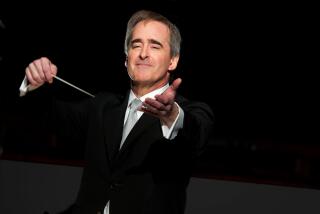Diaghilev Protege : Lifar, 81, Ballet Master at Paris Opera, Dies
- Share via
Serge Lifar, the Diaghilev protege who was the unchallenged premier danseur at the Paris Opera during what is considered by many to be its most creative period, has died in Switzerland, it was reported Tuesday.
His death was announced in Paris and confirmed by a spokeswoman for the luxurious Beau Rivage Hotel in lakeside Lausanne, where Lifar had moved with his wife several months ago. He was 81 and reportedly had been suffering from cancer.
Lifar was the last of the fabled quartet of male dancers featured in Serge Diaghilev’s Ballets Russes , which transformed ballet from a pastime for the elite into an art form for the masses.
With Vaslav Nijinsky, Anton Dolin and Leonide Massine, Lifar toured Europe in the 1920s and was hailed for such personal triumphs as “The Prodigal Son” in George Balanchine’s 1929 creation.
Choreographed 105 Ballets
Beyond his dancing, Lifar--a slight, moody man who was prone to self-admiration when he couldn’t attract it elsewhere--also was a prolific choreographer and author.
When he retired in 1958, he had choreographed 105 ballets (his first was Igor Stravinsky’s “Le Renard” in 1929) and had written several books on dance. He also had been accused of being a Nazi sympathizer and had proved to be an ill-tempered artist prone to challenge his real or imagined enemies to duels.
Lifar was among the first to proclaim the independence of dance from music and in 1935 choreographed “Icare,” a ballet in which the rhythm was provided solely by percussion instruments.
Born the son of a civil servant in Kiev, the capital of the Ukraine, he joined the free classes taught by Bronislava Nijinska, the sister of the legendary Nijinsky, at age 15. Within a year or two she left to rejoin Diaghilev, but she cabled Lifar, then 18, to join the Ballets Russe on the Continent .
Although he eventually rivaled the better-known Nijinsky, Massine and Dolin, Lifar at first was placed in the corps de ballet. With the determination that marked the rest of his career, he managed to charm Diaghilev into better parts, once even having nose surgery to make him look more Oriental.
Balanchine, then Diaghilev’s prime choreographer and later perhaps the most famous name in the dance world, was told to create roles for Lifar. In addition to “Prodigal Son” he was given the title role in “Apollo.”
Paris Opera
After Diaghilev died in 1929, Balanchine asked Lifar to take over the production of Beethoven’s “Creatures of Prometheus” for the Paris Opera. Lifar became principal dancer and ballet master, beginning an association that lasted until his retirement, save for a two-year hiatus after World War II, when he was suspended for supposed collaboration with the Nazi’s Vichy government in occupied France.
Lifar introduced regular ballet nights at the Paris Opera and generally was credited with bringing the opera’s ballet company into step with the new-style classicism that is prevalent today.
However, much of his choreography was seldom performed after his retirement.
His final year as ballet master in Paris did not pass unnoticed. In March, 1958, he challenged an old friend, the Marquis de Cuevas, to a duel after the marquis produced one of Lifar’s ballets and changed some routines.
The duel was done with epees, weapons with sharp points but no cutting edge. During the third two-minute round, the 73-year-old marquis nicked the 53-year-old Lifar on the forearm.
The marquis beamed, Lifar grinned and the two men embraced, having satisfied their codes of honor.
More to Read
The biggest entertainment stories
Get our big stories about Hollywood, film, television, music, arts, culture and more right in your inbox as soon as they publish.
You may occasionally receive promotional content from the Los Angeles Times.










